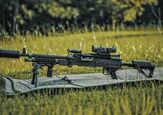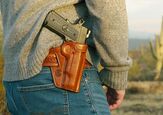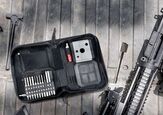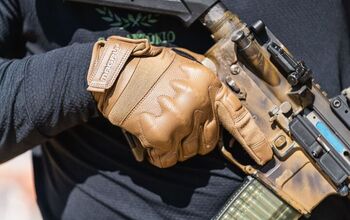Different Kinds Of Handguns, Explained

When you hear the word “handgun,” the image in your mind could vary wildly. Everything from the cowboy revolvers of the Wild West to a modern pistol with a silencer, flashlight, red dot sight, and extended magazine fall into that category. If you are thinking about getting a handgun, understanding the various types is critical. Let’s break them down into categories that can help you find what you are looking for.
Revolvers
Handguns break down into two primary groups: pistols and revolvers. Revolvers hold ammunition in a rotating cylinder. Pulling the trigger or hammer of the revolver rotates the cylinder mechanically, placing the next cartridge in the firing position. Pulling the trigger makes the hammer fall, which impacts the primer and causes the cartridge to fire. Even if the preceding round fails to fire, the next round will still advance to the firing position when the shooter pulls the trigger or hammer.
Revolvers fall into one of two major groups: double action and single action. The hammer must be manually cocked for each shot on a single-action revolver. The trigger only performs a single ‘action’, releasing the hammer to fire the shot. In contrast, double-action revolvers both cock and release the hammer with only the pull of the trigger. A double-action trigger pull is heavier than a single-action because the trigger must do the work of rotating the cylinder and pulling back the hammer, as well as releasing the hammer. Most double-action revolvers can be cocked manually by pulling the hammer back, but some are double-action only and have an internal hammer or “bobbed” hammer that cannot be grasped.
One advantage of revolvers is their reliability. With a double-action revolver, the shooter need only pull the trigger again if the gun fails to fire again. The cylinder will (barring a catastrophic internal failure) rotate again, bringing up another fresh round. The tradeoff of this system is capacity. Revolvers generally hold between five and seven rounds, instead of the 10 or more rounds that most pistols hold. Quality revolvers also tend to be more expensive than common pistols. Later in this article, we will look at some specific models, but the main revolver manufacturers are Smith & Wesson, Ruger, and Colt.
Pistols
The most prevalent handgun today is the semiautomatic pistol. Pistols feature a magazine containing ammunition, which is fed into the gun by the captured recoil (or gas, in some cases) of each shot. Once the pistol is loaded manually for the first shot, successive shots are loaded automatically so long as the gun does not misfire or malfunction. Firing the gun causes the slide of the pistol to cycle to the rear, ejecting the empty brass case, and then loading a fresh round from the magazine as it returns forward. Pistol magazines fit inside the grip of the gun, and are usually double-stack (two columns of bullets in the magazine, thicker but higher capacity) or single-stack (one column of bullets, slimmer but lower capacity).
Essentially all pistols on the market today are semiautomatic, meaning each pull of the trigger fires one shot. Semi auto pistols are commonly chambered in rimfire calibers like the ubiquitous .22 LR, as well as standard centerfire calibers like 9mm and .45 ACP. There are some fully automatic pistols out there like the Glock 18 that fire continuously as long as the trigger is held down, but this is uncommon (and usually highly regulated).
One key advantage of pistols over revolvers is capacity and reload speed. A common handgun like the Glock 17 has a 17-round magazine, which dwarfs the number of rounds in a revolver cylinder. Most popular concealed carry pistols hold more than ten rounds. In addition to greater capacity, ejecting an empty magazine requires only the press of a button, and loading a fresh magazine and chambering another round takes an experienced shooter only a few seconds (or even less, in some hands). Pistols can also weigh less than revolvers, as many pistols have polymer grip frames, while almost all revolvers have full metal construction. Metal frame pistols are not uncommon, though.
Double Action, Single Action, and Striker-Fired
Like revolvers, semiautomatic pistols can be single action or double action, or something in between called “striker fired.” As in a revolver, a single-action pistol only uses the trigger to release a cocked hammer. As the gun fires, the slide moves to the rear and cocks the hammer once again. Some pistols are double-action, and pulling the trigger cocks the hammer and drops it. Just like a revolver, this trigger pull will be heavier because the trigger pull has to set the hammer before it releases the hammer.
Unique to pistols is the double-action/single-action trigger. These “DA/SA” guns typically include a mechanism called a “decocker” that lowers the hammer without firing the gun. The idea of this system is that a DA/SA pistol is carried with a loaded chamber and magazine, but with the hammer in the down position. The first shot is a double-action pull, which is heavier and less likely to happen accidentally. Once the gun fires, the hammer remains cocked and follow-up shots are made in the single-action mode with a much lighter and faster trigger. DA/SA guns were the most common pick for defensive pistols in decades past, but their use has declined at least in part because many shooters struggle to shoot well with the changing trigger function.
Striker-fired pistols do not have a hammer at all. This system was popularized by Glock and has become the most prevalent firing mechanism. Rather than a hammer on the back of the gun, an internal striker mechanism sits mostly cocked. As the trigger is pulled, the striker moves to the rear the last little bit, then drops forward. This trigger pull feels more like a single action than a double action but will tend to be a little longer and squishier than a single action. Every trigger pull is the same with a striker-fired gun.
One of the most famous hammer-fired pistols is the 1911. It was designed by the legendary John Moses Browning, and carried by the US Military for a hundred years. Many shooters today appreciate the ergonomics, excellent single-action-only trigger pull, and historical value of the 1911, though its magazine capacity is limited compared to more modern designs. High-quality 1911s also tend to be more expensive than polymer-framed mass-market pistols.
Size Categories, Explained
All handguns exist in a size spectrum. At one end are large guns that are easy to shoot, but difficult to conceal. They have plenty of internal space to hold a lot of ammunition. At the other end are tiny little pocket pistols that can hide just about anywhere, but are miserable to shoot and hold little ammo. Choosing the right point on that spectrum is critical for long-term satisfaction with a handgun.
The exact breakpoints between each size category are not rigid. Think of these as something like a Venn diagram, with overlap between the circles and guns that may arguably fit into multiple circles at once. Some gun manufacturers also use various words
Full Size
This size group is for guns that are not meant to be concealed. These guns prioritize capacity, ease of shooting, and barrel length over compactness. When you see a uniformed police officer, the gun on their hip will almost always be a full-size model.
The average barrel length is around five inches, but shorter or longer barrels are not uncommon. Long barrels produce higher velocities, which result in more energy on target. Longer barrels also allow for a longer sight radius, spacing the front and rear sights further apart, which is more precise than a shorter radius.
In this category, the grips are long enough for an adult male hand to get a full grasp. Double-stack pistols tend to hold around 17 rounds, some higher, some lower. Single-stack pistols hold 8 rounds or so. Full-size revolvers usually hold six or seven, or sometimes even eight rounds.
Most full-size pistols are chambered in 9mm, .40 S&W, or .45 ACP. Full-size revolvers are typically chambered in .357 Magnum, or larger calibers like .41 Magnum, .45 ACP, .45 Colt, or .44 Magnum.
Pistols
- Glock 17
- Sig Sauer P226
- Colt 1911 (5” barrel)
- Beretta 92
Revolvers
- Smith & Wesson 686 (6” barrel)
- Ruger GP-100
- Colt King Cobra
Compact
Stepping down slightly in size we arrive at compact handguns. These sit in the middle of the spectrum, with respectable capacity and shooting comfort while being more concealable than the full-size models. Most compact pistols are full-size pistols with shortened barrels and grips. A quintessential example is the Glock 19, which is basically a Glock 17 with the grip shortened from holding a 17-round magazine to a 15-round magazine, and half an inch shorter barrel.
Generally, a compact pistol can accept the magazines from the full-size relative. That magazine will hang out of the bottom of the grip but still be functional. Many people who carry compact handguns carry a spare magazine from the full-size gun, because if the need to change magazines arises, concealment will not still be a concern.
In the revolver space, compact models are not really a clear category. The best examples of this class are full-size revolvers with slightly shorter barrels, typically around four inches. Most still have 6-shot cylinders. Whether a compact handgun is a pistol or revolver, the calibers tend to be the same as those of the full-size category.
Pistols
- Smith & Wesson M&P Compact
- Glock 19
- Sig Sauer M11A1
- CZ P-07
Revolvers
- Smith & Wesson 686 (4” barrel)
Subcompact
Subcompact pistols are the smallest size category. These pistols prioritize concealment over capacity and shootability. Most shooters will find that the gun does not fill their hands. Sticking with the Glock example, the Glock 26 is the subcompact 9mm model. It still is a Glock 17 derivative but with the shortest barrel and grip length. The 15-round and 17-round magazines from the larger Glocks still fit in the Glock 26.
Pocket pistols are a subcategory within the subcompact family. These are the smallest pistols possible, and handling and ergonomics are usually sacrificed in the interest of ultimate concealability. Most of these pistols are chambered in .380 ACP, or even .22 LR, in an effort to reduce the size as much as possible.
Subcompact revolvers differ in many ways from the larger guns. Features like shrouded hammers, or even fully internal hammers, are common because standard spur hammers can snag in a pocket or when drawn from under clothing. Most have 5-round cylinders with smaller diameters to aid in concealment. .38 Special remains the most common chambering, but others like .22 Magnum, 9mm, and .327 Federal can also be found.
Subcompact Pistols
- Sig Sauer P365
- Glock 26
- Springfield Armory Hellcat
Pocket Pistols
- Ruger LCP
- KelTec P3AT
- Glock 42
Subcompact Revolvers
- S&W 442
- Ruger LCR
The Oddball Stuff
Almost all handguns fall into one of the above categories, but there are some oddballs that don’t fit neatly in that structure. Pistols like derringers, with two barrels and sizing to fit in the sleeve of a riverboat gambler, do not fit neatly in the traditional categories. There are also big bore revolvers that weigh as much as some rifles, and single-shot bolt action pistols (like the Remington XP 100) that fire cartridges traditionally used in rifles. Specialized target pistols also fall in this category, like those used in certain Olympic shooting sports. Those pistols fit very exacting rule sets and tend to be of little use for anything other than those competitions.
Conclusion
There are a myriad of handguns, but both pistols and revolvers break down into some broad categories. A striker-fired subcompact is a very different gun than a DA/SA compact pistol or single-action revolver. There are advantages and disadvantages to each, but the important thing is matching your needs with the correct category of handgun. This will narrow down a wide field into just those models that fit with what you are trying to do.

AKA @fromtheguncounter on Instagram. Gun nerd, reloader, attorney, and mediocre hunter.
More by Daniel Y
































![[SHOT 2025] New Roller-Delayed Guns From Century Arms](https://cdn-fastly.thefirearmblog.com/media/2025/01/22/22541/shot-2025-new-roller-delayed-guns-from-century-arms.jpg?size=350x220)



![[SHOT 2025] Aimpoint COA Red Dot Sight and A-CUT Footprint](https://cdn-fastly.thefirearmblog.com/media/2025/01/22/14061/shot-2025-aimpoint-coa-red-dot-sight-and-a-cut-footprint.jpg?size=350x220)


Comments
Join the conversation
an old all steel Makarov in 9 x 18 carries nicely also. (BTW... they are actually 9.2 x 18 mm). You can not use 380 acp bullets in these.
Shame on you. As a general review article, you omitted a most famous action- single action only. Colt (and clones) Single Action Army.